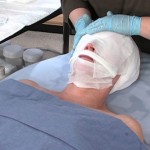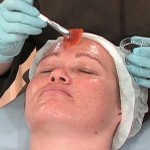Skin Care- High Tech methods
0Every day the skin is assaulted by damaging influences. Some are external, such as sun and air pollution. Others are natural influences, such as aging, fatigue and gravity, or health-related causes, such as diet and stress. As a result, the skin sheds about 80,000 cells each day. These dead skin cells, left on the surface, slow down healthy cell renewal, increase the depth of wrinkles and create a dull, sluggish appearance.
The simple act of exfoliation can counteract the effects of all of these influences on the skin by removing damaged cells on the surface, which allows new live cells to replace the old. Because exfoliation helps to accelerate cell regeneration, the more you effectively exfoliate, the younger the skin looks and the better your skin care products can penetrate deeply.
Some history
Exfoliation is not a new concept. The first known use of dermabrasion as a skin care technique dates back to the ancient Egyptian kings and queens, who used alabaster and pumice to smooth and soften their skin. Some years ago, the term “exfoliation” became a buzzword in the modern-day skin care industry—the fastest way to achieve smoother, younger-looking skin.
The 1960s saw the introduction of mechanical exfoliators that utilize abrasive agents with sharp edges to actually scrape and cut the skin. Apricot seeds were employed first, followed by granulated peach kernels, corn cob, silica, walnut shells and sugar, as well as brushes, sponges and loofahs. This resulted in pulled, torn, stretched, abraded and traumatized skin that was covered with microlesions.
European skin care companies also offered their own professional gommage products at the time. With a strong botanical orientation, they tended to use milder particles as exfoliants, such as almond meal and the newer scientifically size- and form-controlled polyethylene chips, which produced less destructive results.
In the 1980s, a more effective and safer second generation swept the industry—chemical exfoliators, which used ingredients such as glycolic, alpha and lactic acids. However, these methods not only attacked the dead layers, but also dried out new live cells, making skin more susceptible to UV light and environmental damage. Nevertheless, new companies were formed based on glycolic acid—the smooth skin miracle with instant results. Nearly every company in the skin care business joined the trend. In addition, all sorts of alpha hydroxy acids (AHAs) were touted, along with the formula’s pharmaceutical-grade ingredients, highest percentages or special acid blends.
Today’s exfoliation
Exfoliation is defined as the removal of surface dead skin cells, but the goal of the treatment is to clear cellular debris from the surface without damaging the healthy cells underneath. Estheticians throughout the world long have preferred enzymes for exfoliation, but the strong unpleasant odor makes them unmarketable. In Europe, with its botanical tradition and leading-edge technology, a very different answer to the scrubs-and-acids approach has emerged, spearheaded by German enzyme scientists. In developing a new type of exfoliation process, their objective was twofold: to biologically engineer an enzyme without the unpleasant odor; and to control its molecular weight so that only the optimal size needed to successfully enter and exit pores could be captured, thereby maximizing performance.
Due to an advanced crystallization process, scientists successfully have eliminated the objectionable odor.
This was accomplished by bioengineering odorless enzymes from organic barley, resulting in subtilisin—an extracellular bioactive enzyme that catalyzes the breakdown of proteins into polypeptides and dissolves dead skin cells. This ingredient is now skin care’s new powerhouse biological exfoliation. In addition, the second objective was accomplished by perfecting the process that encapsulates enzymes small enough to enter skin pores and remove dead cells, while still big enough to rinse back out and off the skin. These two research achievements have led to a new technology: enzyme-based biological exfoliation.
The biological exfoliation approach utilizes live “intelligent” enzymes that have the ability to distinguish between living tissues and expired nonactive cells in order to exfoliate thoroughly, while preserving a healthy epidermis. This is not about wrinkle reduction, but about the systematic removal of dead cellular debris.
Maximum renewal
Biological exfoliation represents a leap from the first generation of exfoliators, and this new technology is a key component in the ongoing effort to promote maximum skin renewal at all ages. As the skin grows older, its natural cell-renewal efficiency diminishes. The best that can be done is to slow the aging process by speeding up the cell-renewal process enhanced by exfoliation, enabling effective penetration of moisturizers and treatments.
This article was originally published in the October 2006 issue of Skin Inc. Magazine and is being republished with permission. All rights reserved.
Rita Page and Malinda McHenry show you numerous ways of exfoliating the skin, from sugar body scrubs to chemical peels, in Aesthetic VideoSources educational dvds. Videos on every topic related to skin care and body treatments. Visit them today to request a free catalog.





